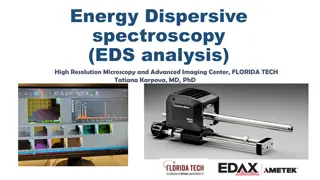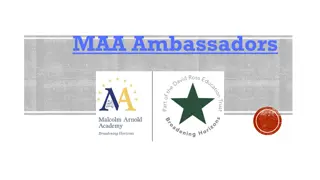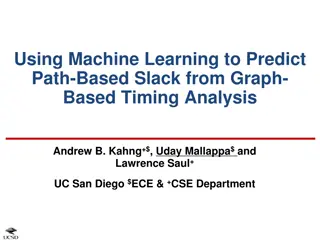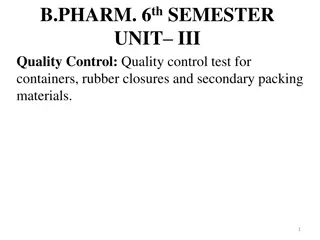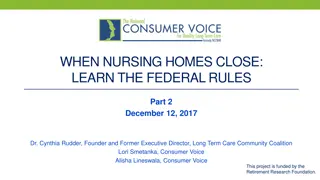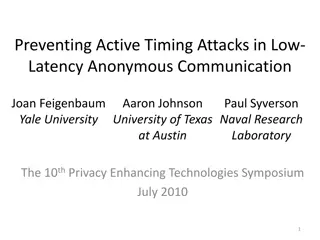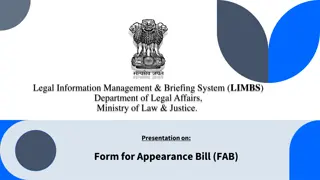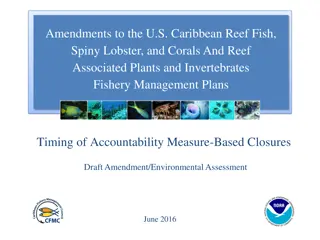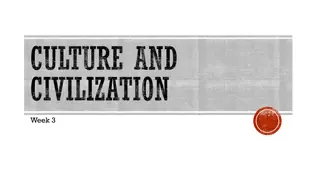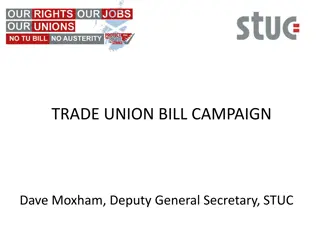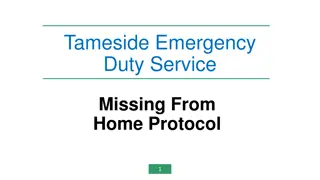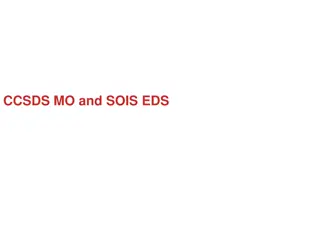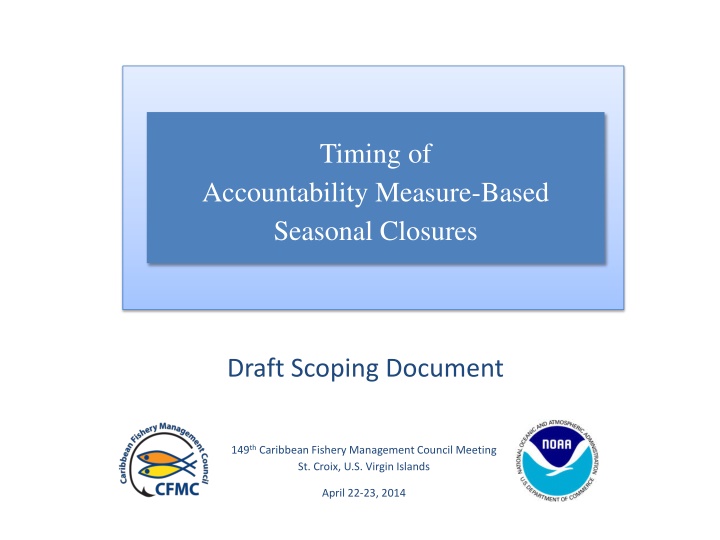
Proposed Action to Improve Accountability Measures for Fishery Management
"Explore the efforts to establish a mechanism considering economic and social impacts in setting accountability measure-based closures for effective fishery management. Discusses goals, objectives, and possible approaches for improving the process. Join the discussion at the Caribbean Fishery Management Council Meeting in St. Croix, U.S. Virgin Islands."
Download Presentation

Please find below an Image/Link to download the presentation.
The content on the website is provided AS IS for your information and personal use only. It may not be sold, licensed, or shared on other websites without obtaining consent from the author. If you encounter any issues during the download, it is possible that the publisher has removed the file from their server.
You are allowed to download the files provided on this website for personal or commercial use, subject to the condition that they are used lawfully. All files are the property of their respective owners.
The content on the website is provided AS IS for your information and personal use only. It may not be sold, licensed, or shared on other websites without obtaining consent from the author.
E N D
Presentation Transcript
Timing of Accountability Measure-Based Seasonal Closures Draft Scoping Document 149th Caribbean Fishery Management Council Meeting St. Croix, U.S. Virgin Islands April 22-23, 2014
Scoping Document (Draft) The purposes of this Scoping Document are to: 1. Identify the issues 2. Solicit input from the public on ways to deal with those issues 3. Provide means of addressing the identified issues (there could be several ways). U.S. Department of Commerce | National Oceanic and Atmospheric Administration | NOAA Fisheries | Page 2
149th Caribbean Fishery Management Council Meeting April 22-23, 2014 Purpose for Action To develop and establish a mechanism that would consider economic and social effects when setting accountability measure (AM)-based closures. Goals: Remain within the corresponding annual catch limits (ACLs) Minimize socio-economic impacts Need for Action To establish a policy and create an environment that provides the Council and NMFS with closure options other than the default end of the year closure in the event of an ACL overage, thus lessening the socio-economic impact of AMs to fishers. U.S. Department of Commerce | National Oceanic and Atmospheric Administration | NOAA Fisheries | Page 3
Inter-related biological, economic, and socio- cultural goals of the proposed action. Biological Economic Social/Cultural Avoid negative socio-cultural and market impacts Stay within the ACL Maximize Revenue U.S. Department of Commerce | National Oceanic and Atmospheric Administration | NOAA Fisheries | Page 4
Objectives of the Proposed Action: 1) To evaluate potential mechanisms for choosing AM-based closure dates 2) To establish a new process (if a new mechanism is chosen) to follow when AMs are triggered 3) To add a new policy into the Council s FMPs to guide when AM closures are implemented U.S. Department of Commerce | National Oceanic and Atmospheric Administration | NOAA Fisheries | Page 5
Possible Approaches for the establishment of AM- Based Seasonal Closures 1) Default AM-Closure Date Take No Action AM-based closures would continue to be implemented beginning on December 31st of the appropriate year and extending backwards in the year for the number of days necessary to achieve the required reduction in landings. U.S. Department of Commerce | National Oceanic and Atmospheric Administration | NOAA Fisheries | Page 6
1) Default AM Closure Date Advantage: AM closures that start on this default date guarantee that the time needed to account for ACL overages can be fully accomplished during the year. Caveats: Identified by fishers as having negative social and economic effects. If several units exceed their ACL during the same year and AMs are required, the resultant closures overlap for at least some period of time, with negative effects. Closing the season from December 31st backwards results in the fishery being closed during the culturally and economically important Christmas season. U.S. Department of Commerce | National Oceanic and Atmospheric Administration | NOAA Fisheries | Page 7
Possible Approaches for the establishment of AM- Based Seasonal Closures 2) Customized Process/Mechanism Change the default AM-closure date - Conduct an analysis every year for each unit that has exceeded its ACL, choose the best date to close the season for the next year based on that specific analysis. - Could use the Seasonal Choices Model or some other method chosen by the Council and approved by its SSC. U.S. Department of Commerce | National Oceanic and Atmospheric Administration | NOAA Fisheries | Page 8
2) Customized Process/Mechanism Advantage: Provides annual flexibility when applying AMs Caveats: Closure would not be implemented in time for it to be effective by the start of the next fishing year. May not be practical because of time requirements: The revised landings data used to make closure determinations are generally not available until late in the year preceding the closure year, especially for the USVI because of fishing year considerations. Time for required regulatory processes: 1. Council meetings for decisions and approval each year 2. Drafting and publishing proposed and final rules implementing dates 3. Public comment periods
Possible Approaches for the establishment of AM- Based Seasonal Closures 3) Upfront Timing Approach (Pre-determined AM-based Closure Dates) Change the default AM-closure date - A one-time pre-determination and establishment of closure dates (e.g., start or end date) for all fishery management units (FMUs) (or alternatively apply the analysis to a selected group of FMUs) - Implementation of chosen date(s) through rulemaking - The start or end date would not have to be the same for each FMU U.S. Department of Commerce | National Oceanic and Atmospheric Administration | NOAA Fisheries | Page 10
3) Upfront Timing Approach (Pre-Determined AM-Based Closure Dates) Selection of pre-determined closures dates for FMUs can be based on any number of considerations, for example: Choosing a start date that occurs at or near the beginning of the year Choosing a date or dates (end or start) that occurs at or near the middle of the year Choosing an end date that occurs near the end of the year, noting that a date at the end of the year is the no action alternative Avoid periods when economic, cultural, and biological considerations take precedence (e.g., Christmas, Lent, spawning season closures). Use components of the Seasonal Choices Model to explore potential dates based on economic, social, and cultural factors Use any other method pre-selected by the Council U.S. Department of Commerce | National Oceanic and Atmospheric Administration | NOAA Fisheries | Page 11
3) Upfront Timing Approach (Pre-Determined Dates) Advantages: Could select start or end dates that avoid having the season closed during important periods such as holidays and spawning season closures. The Council could also choose to exclude from the potential suite of closure dates, periods of time, such as Christmas, Lent, etc., that have been determined to be socio-economically advantageous for fishermen. Pre-selected dates could be revised as needed, but this would not be an annual process. Caveats: Closure dates would be set in advance, but the length of the required closure would not be known. Adequate time must be available to achieve the required closure length. U.S. Department of Commerce | National Oceanic and Atmospheric Administration | NOAA Fisheries | Page 12
Regardless of the approach chosen: Determine how often the selected approach should be revisited, (example: every year, 3 years, 5 years)... Other considerations when developing the approaches could include: May minimize overlap in closure dates among FMUs Consider yearly fishing patterns to look at ways to minimize the impact of AM-based closures Are there any other factors to consider when selecting one closure date vs. another? U.S. Department of Commerce | National Oceanic and Atmospheric Administration | NOAA Fisheries | Page 13
Draft Timeline Today Council reviews PHD/EA, selects preferred alternative(s) and approves for Public Hearings. Council reviews Draft Scoping Document Amendment/EA and Proposed Rule Comment Period Council to schedule Scoping Meetings for Summer 2014. Public Hearings in PR and USVI during Spring 2015 2014 2015 Council discusses outcomes of Public Hearings and considers comments on Amendment/DRAFT EA. Council considers scoping outcomes NOAA publishes Comprehensive Amendment / Final EA and Final Rule. Council passes motion directing staff to develop Public Hearing Draft (PHD)/Environmental Assessment (EA). Council revises and approves codified text. Final Rule Effective Council approves Amendment for Secretarial Review.
Next Steps 1. Motion to Approve/Disapprove Draft Scoping Document 2. Motion to Schedule Scoping Meetings for Spring/Summer 2014 U.S. Department of Commerce | National Oceanic and Atmospheric Administration | NOAA Fisheries | Page 15

